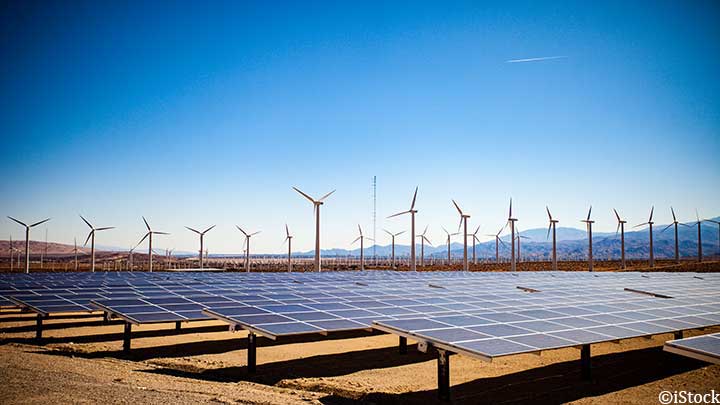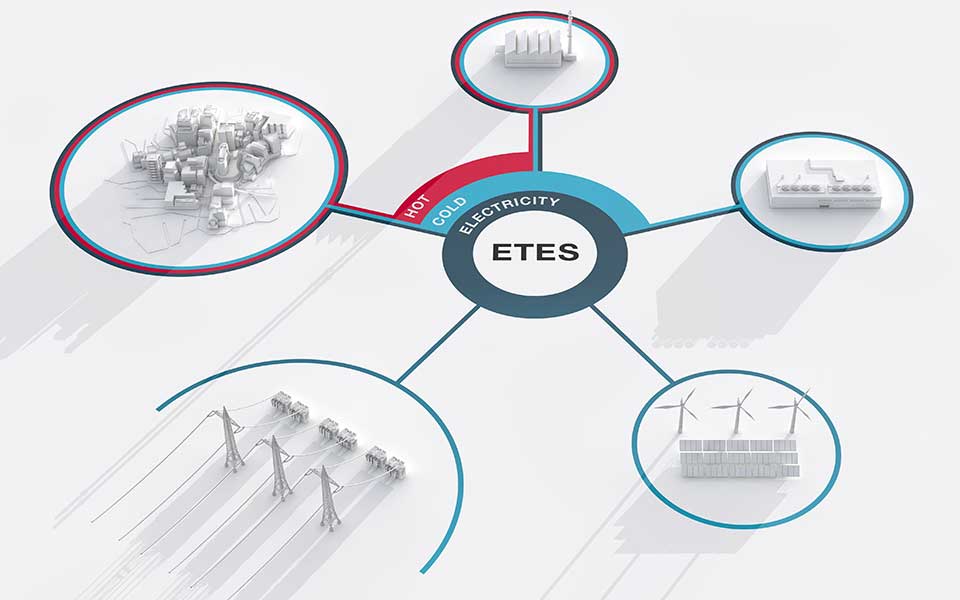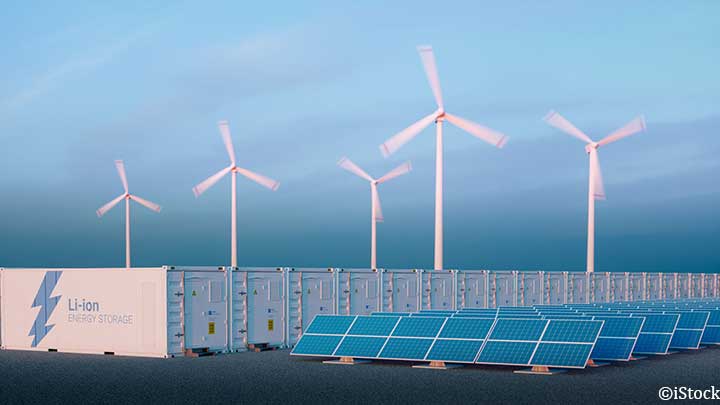The three phases of energy storage to decarbonization
As the world moves toward a decarbonized future, energy storage will become as central to energy systems as generation, transmission and distribution are today. What’s also clear is that we’re unlikely to find a single energy storage technology that will both deliver value to multiple stakeholder groups and meet the great diversity of use cases – ranging from utilities and transmission network operators, to industrial and commercial users, off-grid communities and end consumers.
By Ward Pincus

Dr. Dominik Heiss, Head of Energy Storage at MAN Energy Solutions
The world recognizes that to address climate change, we must work to decarbonize the electricity system. That, in turn, requires a reliance on renewable energy sources such as wind and solar power. However, both of these technologies are defined by fluctuating supply, based on the uncontrollable and relatively unpredictable availability of sunshine and wind. By contrast, conventional fossil-fueled power plants reliably produce as much electricity as the grid requires.
Because the energy grid must continually balance supply and demand, any decarbonized system that relies on intermittent renewable energy “must be able to shift electricity from high production times to high demand times, and eventually even to be able to do this across seasons,” says Dr. Dominik Heiss, Head of Energy Storage at MAN Energy Solutions.
Renewable energy must be able to shift electricity from high production times to high demand times
Energy storage makes this shift possible. However, sometimes this shift is only a matter of minutes or hours, but as we increase the share of renewables in the energy mix, this shift will have to stretch into days and even months. This great variance in the duration of storage requirements leads to the wide diversity in the energy storage technologies available, both today, and in the future.
To better understand the roles of different technologies during the energy decarbonization journey, Heiss divides this transition into three phases: Phase 1 includes the current moment and extends to a time when renewables comprise up to about 40 percent of grid supply. Phase 2 represents the next period, as we move to about 80 percent renewable energy supply. Phase 3 represents the final push to full decarbonization of the energy system.
In Phase 1, Heiss says, “a traditional grid can handle approximately 30-40 percent flexible generation from renewables quite well. In this phase, energy storage, e.g., battery energy storage systems (BESS), plays a supporting role in providing grid services such as frequency regulation and curtailment prevention.”

Storage is key to incorporating renewables
In Phase 2, as the share of renewables grows beyond 40 percent, “it is necessary to actually turn off conventional power generating assets – like coal-fired plants –for longer periods of time to achieve this higher share of renewables.”
This creates a need for larger and longer-duration energy storage that can store and discharge electricity into the grid for up to half a day or longer. “In this phase, energy storage needs to be able to shift large amounts of electricity from high production periods to low-production periods and to periods that have high-energy demand,” Heiss says. Molten salt energy storage (MOSAS) but also compressed air and liquid air solutions can meet this type of need cost effectively.
Phase 3 will make it necessary to “shift electricity over long periods of time, even to seasonal balancing.” Technologies with this long-term storage capability include thermal storage systems that use water or the ground as storage mediums, as well as Power-to-X. Power-to-X plays a particularly important role in this context, since synthetic gas or liquids can also be imported from other geographical regions, effectively reducing the required amount of seasonal storage.
Multiple roles
What makes the energy storage discussion so interesting is that it will take a range of technologies to complete the decarbonization journey. Further, we’ve already seen that storage will play a major role in ensuring the steady supply of intermittent renewable energy, but it also will help decarbonize other sectors like industrial and district heating and cooling, as well as transportation.
For industrial users and large campuses, or urban areas that require large amounts of energy for heating and cooling purposes, thermal energy storage delivers a different type of benefit. By integrating the electrical and the thermal sector, it provides a zero-carbon solution to help address the 39 percent of global CO2 emissions that today come from heating and cooling.
MAN’s electro-thermal energy storage (ETES) “offers an efficient way to convert renewables to thermal heat or cold, but without generating CO2,” Heiss says. “What’s more, you are generating both heat and cold at same time, and that’s ideal for municipalities or industries such as food and beverage manufacturing whose processes require both heat and cold.”
The flexibility of this type of system is such that the stored thermal energy can be both exported for direct use and converted back to electricity later. This can be quite useful and cost effective for some industries with very high, but limited, periods of peak electricity demand.
For industrial and manufacturing companies, Heiss predicts that “storage will become an additional element of their facilities,” because of the benefits it delivers in greater energy efficiency, lower costs, increased security of supply, and especially due to the reduced carbon footprint and emissions.
In transportation, Power-to-X solutions will use electricity generated from renewable energy to produce, for example, hydrogen or synthetic natural gas to effectively convert, store and transport the renewable energy as a fuel for use later on ships or in land-based vehicles.

MAN ETES converts renewable energy to thermal heat or cold without generating CO2.
Storage is not only about 'efficiency'
While the efficiency of a storage system is important, there are other considerations that can be at least, or even more important, such as capital expenses, operating costs, lifetime of an asset and scalability. For example, BESS has an almost linear cost curve, so the more storage you add, the costs increase in parallel, with limited economies of scale,” Heiss explains. But with other technologies, such as molten salt, or compressed or liquid air, you can increase the capacity significantly, while adding only a little cost. This makes these technologies more applicable for large-scale application and for longer-duration energy storage.
Heiss points out that while the round-trip efficiency of Power-to-X is lower than in other technologies, the ability to store the hydrogen or synthetic gas produced by these systems in existing infrastructure means the total system costs are competitive. As well, Power-to-X makes it possible to fully benefit from large renewable capacity and the decreasing generation cost by making it available as synthetic fuel or gas to power other sectors outside the power grid.
In addition, molten salt energy storage in combination with concentrated solar power has the advantage of producing a steady stream of electricity, once the storage medium is heated, even at nighttime when the sun is not shining. Plus, it isn’t impacted by short periods of cloudiness the way a solar PV plant might be. On the other hand, a PV or wind plant combined with battery storage also can manage short periods of cloudiness or low wind.
Storage: A producer or a consumer?

Energy Storage allows to cope with the fluctuating nature of renewables
As with any energy technology, policy and regulation play a key role in enabling or hindering the growth of energy storage. This is particularly relevant for storage, Heiss says, given its dual role as both a consumer and producer of electricity. “It’s important for policymakers to see the value of energy storage in this light” and to write regulations accordingly.
The International Energy Agency’s 2019 report “Tracking Energy Integration” identifies this policy challenge, finding that many regulators consider storage a “generation asset,” while at the same time prohibiting grid operators (who manage transmission and distribution infrastructure) from owning generating assets. This regulatory “Catch-22” means that one of the energy system stakeholders most likely to benefit from holding energy storage assets is blocked from owning them. As the reports points out, transmission and distribution deferral “is one of the highest-value applications for storage.”
The other challenge limiting energy storage is the reality that in many jurisdictions, CO2 emissions carry no or too low a price tag. “When there are too few economic incentives to reduce emissions and support the integration of renewable energy, it can be quite hard to construct a business case for energy storage,” Heiss notes.
This point is reinforced in the IEA report: “Storage deployment remains strongly dependent on supportive policy and market frameworks: Markets are created as and where incentives are introduced.” However, there are already many positive developments in the market, for example by linking renewable generation with energy storage in combined projects. This allows attractive overall project returns for investors, even is the storage system on its own is not yet profitable.
Beginning today with a growing number of energy systems and increasingly in the medium- and long-term, the wide diversity of energy storage technologies will become more and more central to our energy systems. They will not only provide us the critical ability to balance energy supply and demand over short, medium and long durations, but they will become a key enabler for using zero-carbon technologies in all sectors and also outside of the electricity system.
About the author
Ward Pincus is a writer based in Dubai covering energy, healthcare and technology issues across the Middle East.
